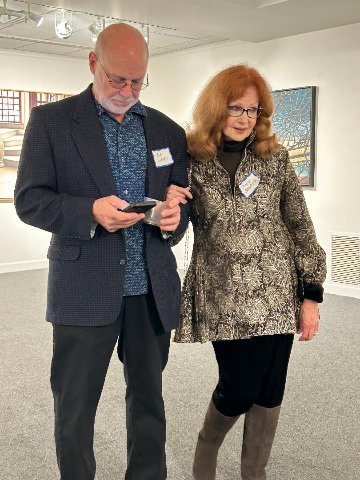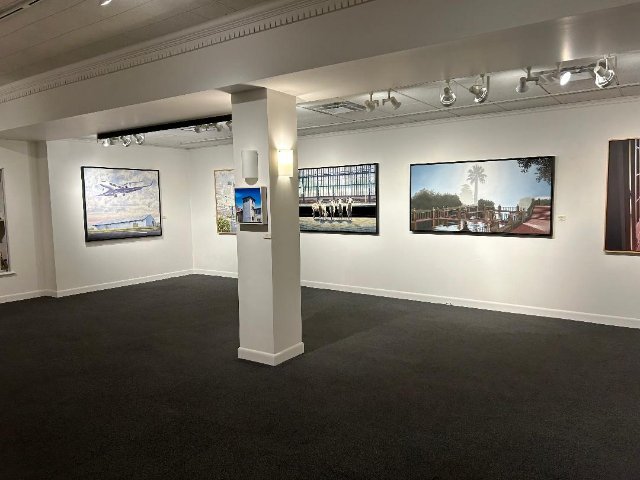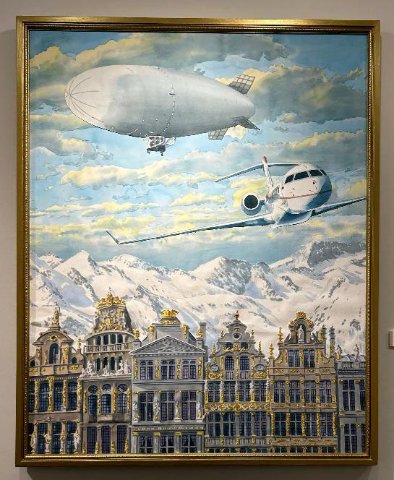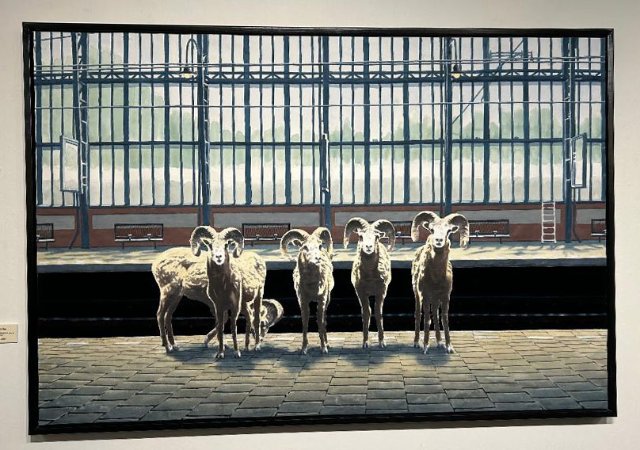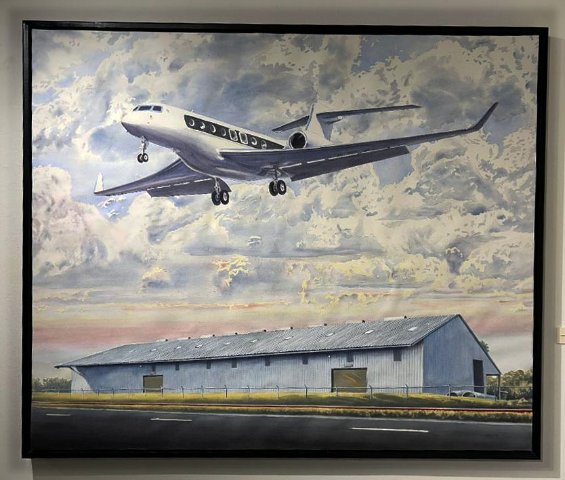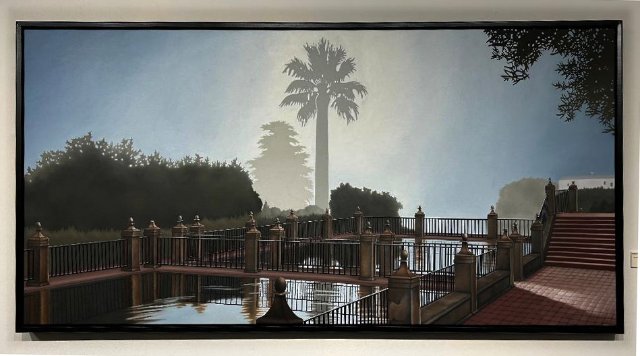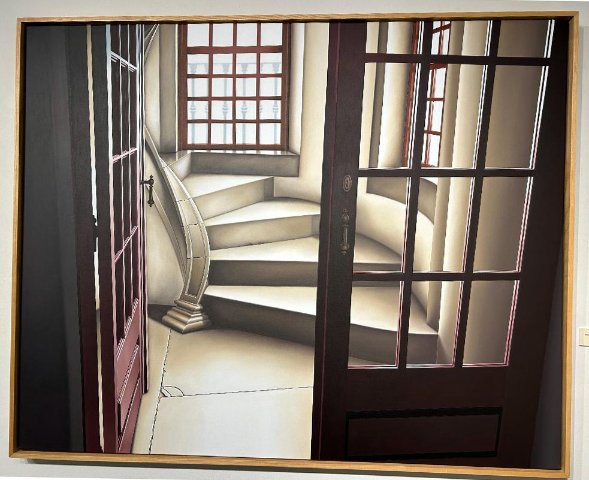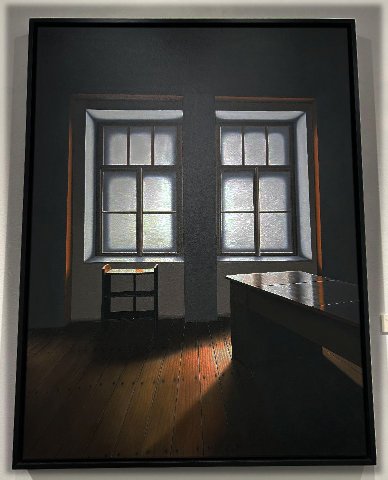Mirror Master: Pennie Brantley and Robert Morgan
LARAC Glens Falls, New York
By: Charles Giuliano - Apr 14, 2024
In 1924 Andre Breton published the “Surrealist Manifesto.” A hundred years later the spirit lives in Mirror Master: Pennie Brantley and Robert Morgan on view through May 15 at Lower Adirondack Regional Arts Council (LARAC) in Glens Falls, New York.
The artist couple takes similar but different approaches to representational painting. With flying saucers hovering in the air his works are overt while her meticulous renderings of fraught interiors are more covert.
They were invited by director Phil Casabona to exhibit in the pristine galleries of a former carriage house in historic downtown Glens Falls.
The Lower Adirondack Regional Arts Council (LARAC) was founded in 1972 to unify the arts community and establish a cultural identity for the region. LARAC supports the local artistic tradition while challenging and inspiring the community’s vision of what art is and what it contributes to our lives.
LARAC hosts exhibitions, workshops, and other arts related events that are open to the public. Services for artists and arts organizations include professional development seminars, gallery and gift shop exhibition opportunities, arts festivals, grants for arts and cultural projects, and more.
Brantley has been invited to exhibit in the group show A Long Affair: Surrealism 1924 to Now, (June 22 to September 15) at the Hyde Museum also in Glens Falls.
The museum states that “Surrealism induced ‘the marvelous’—a feeling of pleasurable disorientation brought about by creative devotion to dreams, the imagination, and the deeply psychological. The variety of themes and visual styles comprising the movement will be represented in the exhibition by works from The Hyde’s strong holdings in Surrealism as well as loans from major institutions.
“The exhibition incorporates artists who may not have been card-carrying devotees of Breton but absorbed the movement’s influence—and demonstrates the longevity and geographic reach of Surrealism’s defining characteristics. On view will be paintings, drawings, prints, and three-dimensional objects from every decade since the 1920s through contemporary makers today.
“The exhibition includes Jean Arp, Pennie Brantley, Leonora Carrington, George Condo, Salvador Dalí, Julio de Diego, Dorothy Dehner, Max Ernst, Karl Fortess, Philip Guston, Wifredo Lam, Georges Malkine, Man Ray, Joan Miró, Wangechi Mutu, Richard Pousette-Dart, Nathaniel Mary Quinn, Kay Sage, Atillio Salemme, Kurt Seligmann, Yves Tanguy, and others.”
Brantley commented that "The new head curator, Derin Tanyol, wants a painting I did in 1985, ‘Who’s Afraid of Vanessa Bell ?’ As you know, she was Virginia Woolf’s sister.
“The National Association of Women Artists is celebrating its 135th anniversary, with many interesting happenings. Hollis Taggart’s ‘blue chip’ gallery in NYC was very generous to host a lovely reception for it. Involved are Faith Ringgold (who has just passed at 93) Audrey Flack, Judy Chicago, and Pat Adams, amongst a few of prominent artists.
“Out of 900 members nationwide, thirteen of us were asked to loan one painting for an exhibition to honor NAWA in a superb reception this past March 21.”
The LARAC two person exhibition is stunning and delightful.
There is amusing whimsy in Morgan’s large format, water color collages. Typically, they merge disparate elements that make us pause and ponder their credible implausibility. This is achieved with such deft legerdemain that it takes a few moments to sort the real from surreal.
In “Mind the Gap,” for example, what are goats staring at us doing in a British transit station? In “Disaster Averted” a blimp hovers over a jumbo jet passing perilously below. The air traffic controller must be puffing weed. A seagull hovers over odd detritus in the whimsical “Cutie’s Pool.”
The meticulously rendered paintings of Brantley derive from their travel in Europe. Some are landscapes and city-scapes while others are based on Caravaggio-like lighting of interiors.
While works like “Indistinct Reflections on the State of the World (Reflecting Pool at the Alcazar de los Reyes Cristianos, Cordona, Spain)” gob smack us with sublime intensity, others are subliminal and invasive.
There is disarming banality to Holocaust based interiors. Now sites for visitation, as she emphasizes, they have been cleaned up and sanitized.
In particular I am absorbed by the monumental simplicity of “Triumph.” In a manner that evokes the deadpan style of Magritte she renders the stumpy branches of trees given an annual pruning. An evolving after image is of amputated limbs set against a brilliant blue sky.
It is always heart warming and insightful to view their passionate work. Duchamp would likely have dubbed it “too retinal” but for me it was just right.



